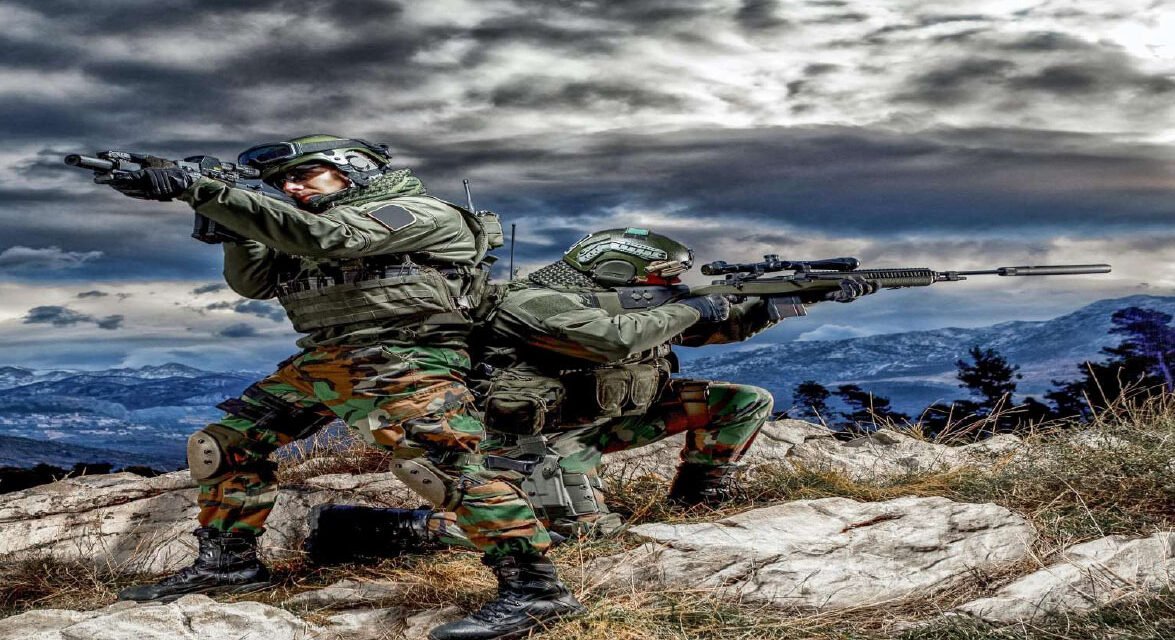Advancements in personal protective equipment (PPE) for soldiers are focused on improving protection, comfort, mobility, and adaptability in a wide range of combat scenarios. Modern developments leverage advanced materials, smart technologies, and ergonomic designs to enhance the survivability and operational effectiveness of soldiers. Here are some key areas of advancement:
1. Advanced Materials for Body Armor
- Lightweight Ballistic Materials:
- Development of materials like ultra-high molecular weight polyethylene (UHMWPE), graphene, and carbon nanotubes for lighter and stronger armor.
- Reduces the physical burden on soldiers while maintaining or improving protection.
- Liquid Armor:
- Shear-thickening fluids that harden upon impact are being integrated into fabrics, offering flexibility during movement and rigidity under threat.
- Ceramic and Composite Plates:
- Improved ceramic composites (e.g., boron carbide) provide enhanced ballistic resistance against high-velocity rounds.
2. Modular Armor Systems
- Scalable Protection:
- Modular designs allow soldiers to adjust their level of protection based on mission requirements, such as removing or adding plates.
- Full-Body Protection:
- Expanding protection to include extremities (e.g., arms and legs) without sacrificing mobility.
3. Helmet Innovations
- Next-Generation Combat Helmets:
- Helmets made from advanced materials like Kevlar and aramid fibers provide better protection against shrapnel and bullets.
- Incorporation of shock-absorbing liners to reduce traumatic brain injuries (TBIs) from blasts or impacts.
- Integrated Technology:
- Built-in communication systems, augmented reality (AR) displays, and night vision optics enhance situational awareness.
- Face Shields and Visors:
- Transparent ballistic face shields offer facial protection without impairing visibility or communication.
4. Smart PPE with Embedded Technology
- Sensors and Monitoring:
- Wearable sensors monitor soldiers’ health metrics (e.g., heart rate, hydration levels, body temperature) and detect signs of fatigue or injury.
- Environmental sensors can alert soldiers to toxic gases or chemical, biological, radiological, and nuclear (CBRN) threats.
- Connected Systems:
- PPE integrated with battlefield networks allows real-time communication and data sharing between soldiers and command centers.
- Energy Harvesting:
- Fabrics embedded with energy-harvesting technologies (e.g., piezoelectric fibers) power electronic devices carried by soldiers.
5. Chemical and Biological Protection
- Enhanced CBRN Suits:
- Lightweight, breathable suits offer protection against chemical, biological, radiological, and nuclear agents while reducing heat stress.
- Self-Decontaminating Materials:
- Advanced coatings and textiles neutralize harmful agents on contact, minimizing the need for external cleaning.
- Integrated Masks and Respirators:
- Compact and ergonomic designs improve usability and ensure compatibility with helmets and other gear.
6. Exoskeletons and Mobility Enhancements
- Powered Exoskeletons:
- Exoskeleton suits reduce physical strain, enhance endurance, and allow soldiers to carry heavier loads.
- Provides protection to joints and reduces the risk of musculoskeletal injuries.
- Passive Exoskeletons:
- Lightweight, non-powered systems assist with load distribution and movement without the need for batteries.
7. Advanced Combat Uniforms
- Fire-Resistant Fabrics:
- Uniforms made from flame-resistant materials reduce the risk of burns in combat scenarios.
- Adaptive Camouflage:
- Fabrics embedded with nanotechnology or color-changing materials adapt to the surrounding environment, enhancing concealment.
- Moisture-Wicking and Cooling Technologies:
- Improved fabrics manage sweat and heat to keep soldiers comfortable in extreme conditions.
8. Enhanced Footwear
- Blast-Resistant Boots:
- Boots designed to mitigate the effects of IED explosions on soldiers’ feet and lower legs.
- Ergonomic and Durable Designs:
- Lightweight, flexible, and durable materials improve comfort and reduce fatigue during long missions.
- Integrated Insoles:
- Insoles with shock absorption and embedded sensors to monitor foot pressure and detect injuries.
9. Threat Detection and Mitigation
- Integrated Sensors for Ballistic Impact:
- Body armor with embedded sensors detects the location and severity of ballistic impacts, enabling immediate medical attention.
- Explosion Mitigation:
- Advanced padding and materials in PPE reduce the impact of shockwaves from nearby explosions.
10. Future Concepts and Experimental Technologies
- Reactive Armor:
- Body armor that actively counteracts incoming threats using micro-explosives or electromagnetically hardened materials.
- Nanotechnology:
- Nano-coatings and nanofibers enhance the durability, flexibility, and protective capabilities of PPE.
- Artificial Intelligence Integration:
- AI systems analyze sensor data to predict and warn soldiers about imminent threats in real-time.
11. Sustainability and Maintenance
- Self-Healing Materials:
- Fabrics and armor capable of repairing minor damage autonomously, extending the lifespan of PPE.
- Recyclable and Biodegradable Components:
- Environmentally friendly materials reduce logistical burdens and waste in military operations.
Strategic Benefits
- Improved Soldier Performance:
- Lightweight and ergonomic designs minimize fatigue and maximize agility, enabling soldiers to perform better in combat.
- Increased Survivability:
- Advanced protection against a wider range of threats ensures higher survival rates in dangerous environments.
- Enhanced Mission Adaptability:
- Modular and integrated technologies allow soldiers to tailor their gear to specific missions and threats.
In conclusion, advancements in PPE for soldiers are pushing the boundaries of protection, functionality, and comfort. These innovations ensure that modern soldiers are better equipped to face the complexities of the battlefield while maintaining their health and effectiveness in prolonged and dynamic engagements.
Hashtags
#MilitaryPPE #SoldierProtection #AdvancedPPE #CombatGearInnovation #DefenseEquipment #NextGenPPE #AdvancedProtectiveGear #SmartPPE #AIInProtection #BallisticProtection #BodyArmorTech #CBRNDefense #LightweightPPE #ThermalProtectionGear #EcoFriendlyPPE #FutureOfPPE













